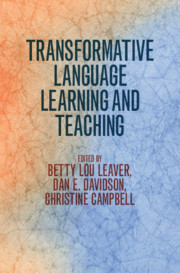Book contents
- Transformative Language Learning and Teaching
- Transformative Language Learning and Teaching
- Copyright page
- Contents
- Figures
- Tables
- Contributors
- Foreword
- Acknowledgments
- Abbreviations
- 1 Introduction
- Part I Theoretical Framework
- Part II Transformative Language Learning and Teaching Applications in Government Programs
- 5 Open Architecture Curricular Design
- 6 Foreign Language Learning Efficiency
- 7 The Challenges of Implementing Transformative Pedagogy
- Part III Transformative Language Learning and Teaching Applications in University Programs
- Part IV Transformative Language Learning and Teaching Applications in Immersion Programs
- Part V The Learner
- Part VI Faculty Development
- Part VII Assessment
- References
- Index
7 - The Challenges of Implementing Transformative Pedagogy
from Part II - Transformative Language Learning and Teaching Applications in Government Programs
Published online by Cambridge University Press: 26 January 2021
- Transformative Language Learning and Teaching
- Transformative Language Learning and Teaching
- Copyright page
- Contents
- Figures
- Tables
- Contributors
- Foreword
- Acknowledgments
- Abbreviations
- 1 Introduction
- Part I Theoretical Framework
- Part II Transformative Language Learning and Teaching Applications in Government Programs
- 5 Open Architecture Curricular Design
- 6 Foreign Language Learning Efficiency
- 7 The Challenges of Implementing Transformative Pedagogy
- Part III Transformative Language Learning and Teaching Applications in University Programs
- Part IV Transformative Language Learning and Teaching Applications in Immersion Programs
- Part V The Learner
- Part VI Faculty Development
- Part VII Assessment
- References
- Index
Summary
This chapter focuses on implementing transformative pedagogy as a solution to support students in their learning rather than feeding into their learning anxiety. The officers who join the Ecole de guerre (French War College) have been taught English through communicative and transactional methods, acquiring grammar and linguistics rather than the ability to communicate in the language. Provided in this chapter is a description of the implementation of a new approach, TLLT, based on learner autonomy and the lessons learned in the process: (1) the need for caution in analyzing the learning environment to avoid introducing a method without properly adapting it, (2) the transition from one method to another that allows the metanoic process and transformation to happen, and (3) all all the key players - the head of department/course designer, the faculty, the leadership of the college and, last but not least, the students experienced the metanoia. The most important lesson? When students realize that TLLT is about transforming their frame of reference and not re-setting who they are, their motivation rockets through the roof.
Keywords
- Type
- Chapter
- Information
- Transformative Language Learning and Teaching , pp. 61 - 68Publisher: Cambridge University PressPrint publication year: 2021

